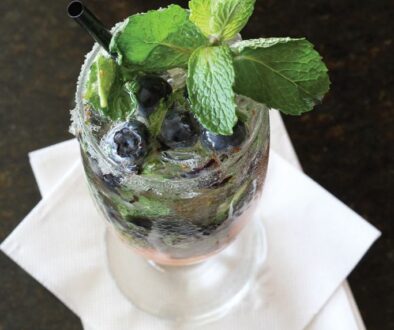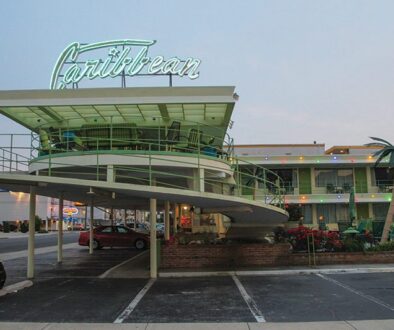A passion for the past

On a crisp fall morning, while exploring Cape May County’s richly colored trails and idyllic back roads, you might find yourself happening upon a small pond in a wooded section of Cape May Court House. You may be charmed at the sight of ducks floating peacefully on the water’s surface. It is not an unusual sight until the serenity is unsettled by a sudden splash. A dog darts into the water to retrieve a bright orange object that has been thrown among the ducks. A young man wearing a green Mackinaw cap steps into a clearing and sips from a steaming thermos. He watches the dog navigate its way through the ducks and return to bank of the pond with the orange foam training bumper in its mouth. The man is 21-year-old Cooper Rossner, and the ducks, as well as the dog, are his. The dog is being trained for its first season of duck hunting. The ducks are wooden, and are products of Cooper’s devotion to the folk art tradition of duck decoys.
Only five years ago, Cooper was studying Natural Sciences at Cape May County Technical High School when craftsmen Dave Billig and J.P. Hand presented a decoy-making demonstration for his class. “They used a hatchet to chop full-size Canada geese,” Cooper said. “To see someone go at a piece of wood with a hatchet and have it turn out to be a beautiful goose made me fall in love with the craft.” It was a love for tradition that had already been cultivated in Cooper’s childhood. “I owe it all to my mom,” he said of his passion for the past. “She had always taken me to antique shows and introduced me to the world of collecting.” In addition to earning an Associate’s degree in History, Cooper has spent his post-high school years perfecting decoys and honing his carving skills at a staggering rate. “When I lie in bed at night I am still thinking about decoys.” Cooper said of his passion. “I speak to my mentor, J.P. Hand, each day.”
Cooper’s love and respect for decoys goes well beyond the obvious artistry that he quickly mastered under the guidance of J.P Hand. For Cooper, the duck decoy is a tangible slice of Americana in which his passion for folk art, history, woodworking, and the natural world all intersect.
Although duck decoys began to flourish in the latter half of the 19th century, their origin is unclear among historians. However, Cooper’s drive for preserving this uniquely American art form, in nothing short of perfection, has made him a respected and sought-after craftsman to both seasoned hunters and discriminating collectors alike.
Secluded in a wooded area of Cape May Court House, just a short stroll from the pond on which he will train his dog for duck hunting, Cooper lives and creates his decoys on his family’s property. The first sensation upon entering Cooper’s workshop is that of entering the studio of any devoted artist: the combined smells of fresh paint and wood shavings, along with the sight of multiple decoys in various states of completion. The visitor feels a sense of privilege in having a behind-the-scenes peek of great works in progress. Wearing worn jeans and flannel shirt, looking every bit the all-American outdoorsman, Cooper proudly gives the tour of his workshop. But beneath the rugged appearance lies a passionate conservationist and multifaceted folk artist, insightful and skilled beyond his years.
Using only white cedar in making his decoys, Cooper carries on a rich tradition in the craft. “Cape May County was once plentiful with white cedar forests, which were sawed and milled for ship building, shingles and clapboards,” Cooper said. “Cape May County’s wealth was in its timber.”

With their rounded and slick-surfaced bodies, Cooper’s decoys are characteristic of the Barnegat Bay style, most commonly seen from Tuckerton south to Cape May. Cooper paints his hollow-bodied decoys in a refined “bayman” style, a term referring to the application of paint being basic enough so that the average bayman could repaint it if the need arose. Although no style of decoy has ever been attributed to Cape May, Cooper is quick to express his desire for such a style, but explains that noticeable details of such a specific, regional style would only emerge after many years—if not generations—of development through local artisans. “Many contemporary makers have blended elements from different styles and have come up with their own,” Cooper said. “That’s what is working for me right now. My mentor told me, ‘Make ducks to suit yourself and hope someone else likes them enough to buy them.’”
While power tools might speed the process, Cooper prefers other methods. In preserving the time-honored ways of the craft, Cooper works only with hand-held tools and in many cases, the antique tools that he has collected. “Tradition is the force that drives me,” Cooper said. “I’ve tried power tools and Dremels, and I don’t like the look it gives the decoy. I couldn’t think of a more beautiful way than to hand carve it.”
Unlike many decoy makers who carve one product at a time, Cooper finds the most efficient process to be an assembly-line fashion. Displayed above his work table is a recently completed batch of eleven decoys. He explained the first stage of the process for these ducks had been chopping all the body forms from milled cedar. Carving the heads as separate components is another stage, gluing and tacking the heads to the bodies yet another, until the process is completed with the painting stage. Each decoy receives his undivided attention, making every duck in the batch a unique example of the art. Comparing his fine, detailed craftsmanship to the rougher qualities of more primitive and utilitarian decoys, Cooper said, “I was taught to carve them in a way that if you were to close your eyes and run your hand along it, it would feel like one piece.”
With affordable resin, plastic and even inflatable decoys available through any hunting supplier or sporting goods store, many waterfowl hunters will pay in excess of $100.00 for a single decoy of Cooper’s. He offered a simple explanation for this. “The reason they prefer a hand-carved decoy is nostalgia,” Cooper said. “They’re like me and are drawn to traditional ways of American life.” One discerning waterfowl hunter in Maryland owns twelve of Cooper’s wood ducks. “He can afford it and it’s attractive to him,” Cooper said of his customer. “There’s something more romantic about saying, ‘All my ducks get shot over hand-carved wooden decoys from Cape May County, New Jersey,’ than it is to say, ‘Me and my buddies got our limit the modern way with plastic decoys and motors on our boats.’”
Cooper’s artistic skills extend well beyond ducks for hunters. He also makes shorebird decoys used in attracting migratory birds that are banded and released by The Wetlands Institute of Stone Harbor in a conservation effort to monitor the birds’ activity. The New Jersey Audubon Society uses 15 of Cooper’s shorebird decoys to attract terns and skimmers to replenish their population on the beach.
Americans haven’t always had a good record in their relationship with birds. In the late 19th century, the passenger pigeon was hunted to extinction, when once there were so many that they darkened the sky. Egrets, commonly seen in Cape May County’s estuaries, were nearly hunted to extinction in the early 20th century for the frivolous purpose of using their plumes in millinery. Other shorebirds were similarly affected. “Shorebird hunting has become a forgotten part of Cape May’s history,” Cooper explained. “It was very lucrative in Cape May. People wonder why we are so dedicated to shorebird conservation and it’s because we were so brutal on them.” On occasion, Cooper has been confronted by those who see his love of waterfowl hunting to be contradictory to his passion for shorebird conservation. “There’s no contradiction,” Cooper said, “It’s the same game. People ask me, ‘How can you kill such a beautiful creature?’ What’s beautiful is when I am out hunting with my dog and my dad and my mentor. I’m not just connected to nature, I am part of it. I don’t mean to trash-talk anyone who doesn’t hunt, but I’m connected to the world around me more than they are, and I can say that with a straight face.”
Cooper’s right-hand man in this enterprise is his dog Pilot, a one-year-old German Shorthaired Pointer, or as Cooper simply puts it, a bird dog. Cooper purchased Pilot from a breeder who sells exclusively to hunting households. Named for the many river pilots Cape May County had during the Revolutionary War, Pilot seems to complete the all-American picture at his master’s side. More than Cooper’s best friend, Pilot is a muse of sorts to him, appearing as the subject and at times the narrator in many of Cooper’s humorous folk writings which are influenced by his literary idols, Havilah Babcock and Eric Sloane. Although Cooper will be training him to hunt with decoys this fall, he originally got Pilot for woodcock and rail bird hunting. Unlike a duck dog that retrieves what has been shot, Pilot finds the birds in tall, marsh grass and indicates their presence with his posture, at which point Cooper will flush or startle the birds from their roost so he can shoot them. “Eventually I want him to be a versatile dog, able to hunt any terrain, any time, for any bird,” Cooper said. While Cooper enjoys the fruits of his and Pilot’s labor, he admits an area in which he is determined to improve. “Rail birds are delicious but I’m not a very good cook,” Cooper said. “My girlfriend is a vegetarian, so she doesn’t cook them for me. I gotta work on the cooking end of it to complete the cycle with style.”
As a businessman, this outdoorsman is just as laid back. “If nobody ever buys another duck from me, I’ll be just as happy,” Cooper said. “My future in this business is my presence. I just want to help and teach as many people as I can.” When asked where people can view and purchase his decoys, he eagerly said, “Just call me, because I love hanging out with people. Through decoys I’ve made some of the best friends that a guy could ever ask for.”
Two of the friends Cooper met through his decoy making are Dan and Lindsay Casale, owners of Makers Making on the Washington Street Mall in Cape May, which sells Cooper’s decoys made in his characteristic Philadelphia style. Dan and Lindsay have been instrumental in introducing Cooper and his work to the public and to collectors of fine crafts. “His live demonstration was incredible,” Lindsay said of a recent decoy-making demonstration Cooper held in their store. “His skill and patience are evident in each finished decoy. Dan and I are so pleased to offer a platform to something so deeply rooted in South Jersey history.”
The popular, redefined image of outdoorsmen and hunters as presented on television is one with which Cooper has mixed feelings, the most conspicuous being that of the reality television series Duck Dynasty, featuring a family of bearded duck hunters with conservative views. “Duck Dynasty and similar representations in popular culture have put the spotlight on water-fowling,” Cooper said. “It has certainly done more good than bad for sportsmen. It seems hip to be an outdoorsman nowadays. It also promotes waterfowl hunting, which requires the purchase of a Federal Duck Stamp which helps fund wildlife preservation.” Cooper has reservations towards such trendy presentations. “Shows like Duck Dynasty have also played into a stereotype that I don’t like—that if you’re a hunter you must be a redneck,” Cooper said. “If you ask me what I am, I will tell you I’m an artist, a writer, a friend, a student and a family man. I don’t put killing things at the top of my priority list.” He is amused at companies that adopt the outdoorsman style for their merchandising. “I look at a guy in an Urban Outfitters ad who has a beard, flannel shirt and an axe over his shoulder,” Cooper said, “and I know he wouldn’t survive a day in the wild. The guys I run with have flannel shirts with holes in them and paint stains on them.”

In defense of the sporting culture, Cooper points out that is not comprised solely of older, white, mostly conservative males. He cites his close friendship with Laurel Dabbs of Ohio, a respected female artisan whom he lists as one of his favorite contemporary carvers. “I also know gay, lesbian, black and Hispanic members of the community,” Cooper said. “It’s a welcoming community. America is beautiful because we’re all different. And as a microcosm of America, the decoy market and sporting culture is a perfect one. It takes a very refined and cerebral guy or gal to get involved with the world of decoys, because you can’t half-ass it. It deserves respect and as long as I’m around that’s all it will ever get.”
The future of decoy making and the preservation of sporting culture traditions seem to be in nurturing hands with Cooper Rossner. Perhaps the yet undefined Cape May style of decoy that future collectors will seek and carvers will emulate is already emerging with each shaving of white cedar that falls to the floor of Cooper’s workshop. “I ain’t going nowhere,” Cooper said proudly as he evaluated his role in the culture he so dearly loves. “I hope to one day be considered a mentor, buyer, seller—but most of all, a friend to the heritage.”



